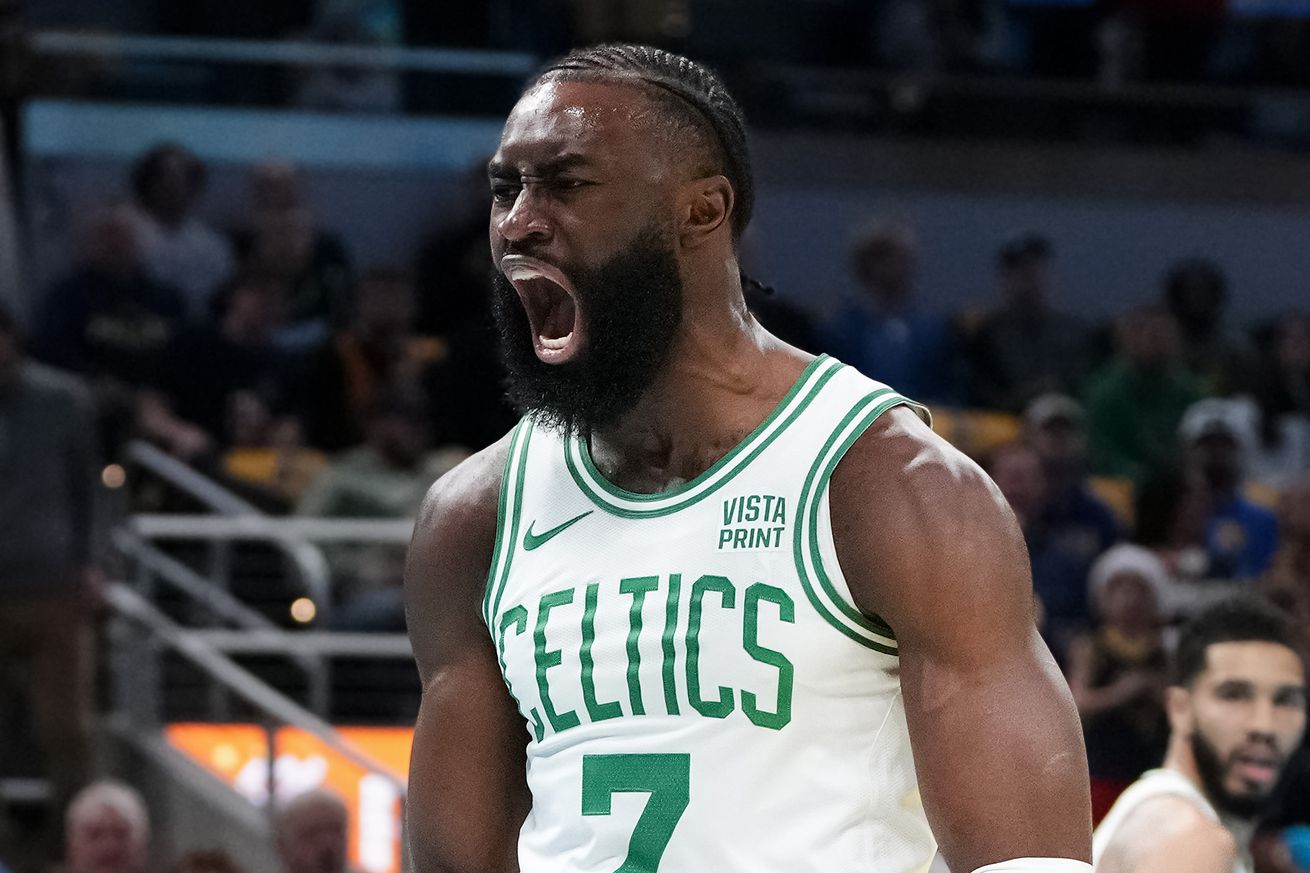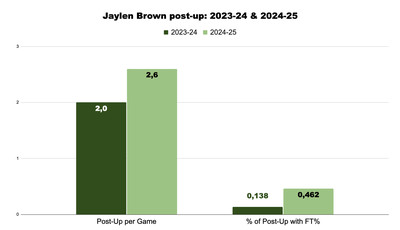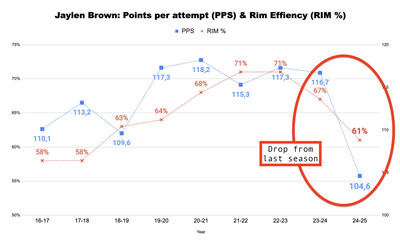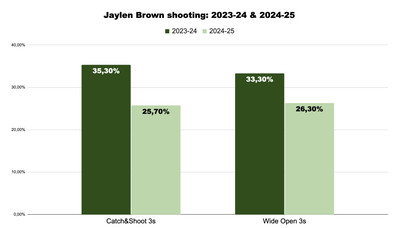
Jaylen Brown’s scoring is up from 23 to 25.6 points per game this season, but the real story lies in the details—his growth in free-throw generation, increased self-creation, and the challenges affecting his scoring efficiency.
This summer, the CelticsBlog crew shared high expectations for Jaylen Brown heading into the regular season. After earning Finals MVP honors, the spotlight was on him. Three major focus areas were identified: his ability to generate free throws, his efficiency, and his passing game. Now that ten games have passed, how does Jaylen Brown’s performance compare to last season? Is he on track to meet those expectations?
Free-throw generation
To provide some context, in his rookie season, Jaylen Brown drew fouls on over 14% of his shots, placing him in the 90th percentile—a very promising start. This metric reflects a player’s ability to generate “easy” points at the free-throw line.
Typically, this percentage increases as players gain experience, physical strength, and the respect of referees—barring physical decline. However, Jaylen’s Shooting Fouled Rate (SFLD%) stagnated after his rookie season, hovering above average but not at elite levels.
(video above: post-up on a mismatch and generates free-throws)
This season, though, marks a breakthrough. Brown’s SFLD% has jumped from 11.5% last season to 15.6% this year, placing him in the 93rd percentile among NBA wings. What has caused this improvement?
One key change is Brown’s approach in post-up situations. Last season, he wasn’t as aggressive in these scenarios. This year, once he gets into post-up position, he actively hunts for better positioning and higher-percentage shots, often targeting weaker defenders.

The Celtics are deliberate about hunting mismatches. This year, Brown has turned post-ups into a weapon for generating free throws. Last season, he drew fouls on 13.8% of his post-ups; this season, that figure has skyrocketed to 46.2%. This remarkable increase suggests a deliberate and effective shift in strategy.
(video above: post-up on a mismatch and makes the field goal plus the foul)
Kristaps Porziņģis and Jayson Tatum led the Celtics’ post-up evolution last season. This year, Jaylen Brown is reaping the benefits of that approach.
Additionally, Brown’s free-throw percentage has climbed closer to 80%, further bolstering his scoring efficiency. However, has this improvement translated into overall efficiency gains?
Scoring efficiency
While Brown’s free-throw efficiency has improved, his overall scoring efficiency has dropped compared to last season. In fact, he is currently less efficient than at any point in his career.
The small sample size should be noted, but some trends indicate an evolution in Brown’s scoring game that has affected his efficiency.
The most significant change is his increased self-creation. Last season, 48% of Brown’s field goals were assisted. This year, that number has fallen to 38%, meaning he is creating more of his own shots. Self-creation often results in more difficult attempts with less help from teammates.

To illustrate this shift, consider that Brown’s shot attempts after seven or more dribbles have increased by 26%, and his drives per game have risen from 10 to 14. However, his drives seem slower, and the team’s spacing isn’t as effective as last season. These factors likely contribute to his drop in efficiency on drives, at the rim, and in isolation plays.
(video above: drives on a slow Brook Lopez but doesn’t create enough space to finish at the rim)
Adding to the challenge, Brown is struggling with his outside shot. His catch-and-shoot and wide-open three-point percentages have fallen from 35% to 25%. While this is concerning, shooting slumps are often temporary and he’s been dealing with a nagging hip flexor injury since the start of the season. This variability highlights the importance of evaluating efficiency over a larger sample size.

To summarize, while there are worrying signs—such as decreased efficiency on drives and isolations—the drop in efficiency is not as dire as it seems. His shooting is likely to recover, and his new approach shows promise.
Passing game
Given Brown’s increased role in shot creation, one might expect an improvement in his passing game. However, his assist numbers remain unchanged. This raises the question of whether there no room for more passing, or is Brown missing opportunities?
Brown’s increased self-creation has focused primarily on his own scoring, which has had a double-negative effect: his efficiency has dropped, and he isn’t creating as much for teammates. For example, his drive volume has increased, but his passing out of drives has not.
(video above: drives, draws defense attention but doesn’t look for open teammates)
This season, we’re witnessing Jaylen Brown take on a new role in the Celtics’ offense. Adjusting to this role will take time as he learns to balance scoring and playmaking for himself and the team. Kristaps Porziņģis’ return will likely help, as we saw how effective Brown was last year with Porziņģis on the court.
(video above: souvenir of the great synergy between Cookies & Cream)
It will be fascinating to see if Brown can sustain his improved post-up game while regaining his shooting touch. At 28 years old, he is proving he can still evolve and adapt his approach. Let’s be patient, stay curious, and keep an eye on his development.